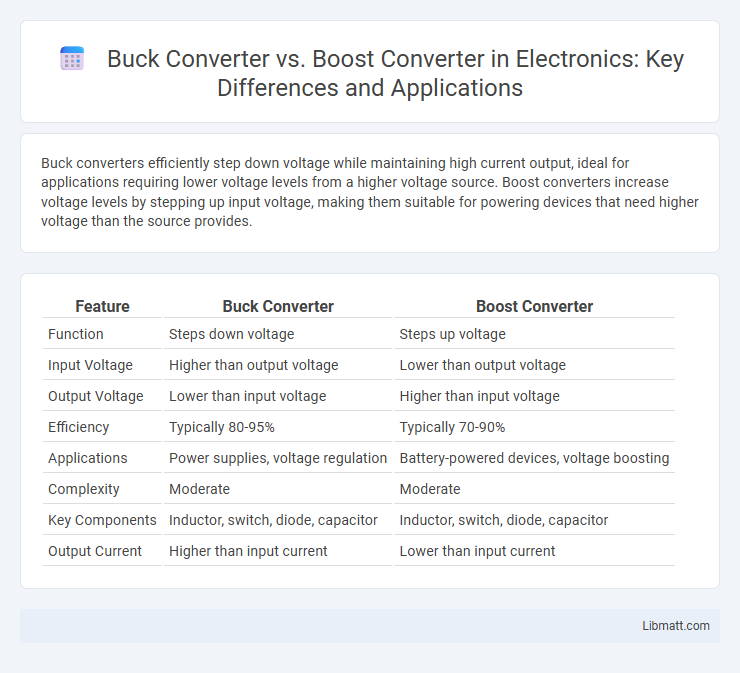Buck converters efficiently step down voltage while maintaining high current output, ideal for applications requiring lower voltage levels from a higher voltage source. Boost converters increase voltage levels by stepping up input voltage, making them suitable for powering devices that need higher voltage than the source provides.
Table of Comparison
| Feature | Buck Converter | Boost Converter |
|---|---|---|
| Function | Steps down voltage | Steps up voltage |
| Input Voltage | Higher than output voltage | Lower than output voltage |
| Output Voltage | Lower than input voltage | Higher than input voltage |
| Efficiency | Typically 80-95% | Typically 70-90% |
| Applications | Power supplies, voltage regulation | Battery-powered devices, voltage boosting |
| Complexity | Moderate | Moderate |
| Key Components | Inductor, switch, diode, capacitor | Inductor, switch, diode, capacitor |
| Output Current | Higher than input current | Lower than input current |
Introduction to Buck and Boost Converters
Buck converters and boost converters are essential DC-DC power regulation devices used in electronic circuits to manage voltage levels efficiently. A buck converter steps down voltage from a higher input to a lower output, optimizing power delivery in battery-operated devices, while a boost converter increases voltage from a lower input to a higher output, crucial for applications requiring stable higher voltage. Your understanding of these converters enables improved design choices in power management systems for enhanced energy efficiency and performance.
Core Principles of Buck and Boost Converters
Buck converters operate by switching a transistor and controlling an inductor to step down voltage efficiently, reducing higher input voltage to a lower output voltage while maintaining energy conservation. Boost converters increase voltage by storing energy in an inductor during the transistor's on-time and releasing it to the load at a higher voltage during the off-time, effectively stepping up your input voltage. Both converters rely on pulse-width modulation (PWM) to regulate output voltage by adjusting the duty cycle of the switch.
Circuit Design Differences
Buck converters feature a circuit design that steps down voltage using a switch, diode, inductor, and capacitor, where the transistor operates as a high-frequency switch to regulate output voltage below the input. Boost converters, in contrast, increase voltage by storing energy in the inductor when the switch is closed and releasing it to the output when the switch opens, requiring a different arrangement of components to achieve voltage step-up. Understanding these circuit design differences helps optimize your choice for voltage regulation efficiency and application-specific requirements.
Voltage Regulation Capabilities
Buck converters excel at voltage regulation by efficiently stepping down higher input voltages to stable, lower output voltages, ensuring minimal voltage ripple and high accuracy. Boost converters regulate voltage by stepping up lower input voltages to a required higher level, maintaining stable output under varying load conditions. Your choice between the two depends on whether your application demands voltage reduction or elevation with precise control.
Efficiency Comparison
Buck converters typically achieve efficiency levels of 85-95% by stepping down voltage with minimal power loss, making them ideal for applications requiring voltage reduction. Boost converters, which increase voltage, generally operate at slightly lower efficiencies around 80-90% due to higher switching losses and increased current stress on components. Understanding these efficiency differences helps you select the right converter to optimize power conversion and thermal management in your electronic designs.
Key Applications of Buck Converters
Buck converters are widely used in power supplies for portable electronics, where efficient voltage step-down is critical to prolong battery life. They are essential in automotive electronics for providing stable lower voltage rails from higher car battery voltages. These converters also play a key role in industrial automation systems by supplying regulated voltage to sensitive components.
Key Applications of Boost Converters
Boost converters are widely used in applications requiring voltage step-up from lower input levels, such as battery-powered devices, where maintaining extended battery life is critical. They are essential in power management for portable electronics, LED drivers, and energy harvesting systems, enabling efficient voltage regulation under varying load conditions. The high efficiency and compact size make boost converters ideal for automotive power supplies and renewable energy applications like solar power systems.
Advantages and Disadvantages
Buck converters efficiently step down voltage with high efficiency and low heat generation, making them ideal for battery-powered devices, but they cannot increase voltage beyond the input level. Boost converters step up voltage, allowing you to power higher voltage components from lower voltage sources, but they typically generate more electromagnetic interference and require more complex control. Your choice depends on whether you need voltage reduction or elevation, balancing efficiency, complexity, and application requirements.
Selection Criteria for Power Supplies
When selecting between a buck converter and a boost converter for your power supply, consider the input and output voltage requirements; a buck converter steps down voltage efficiently for applications needing lower voltage than the source, while a boost converter increases voltage when the output must exceed the input level. Efficiency, load current capacity, and thermal management are critical factors influencing this choice, as buck converters typically have higher efficiency at higher currents, whereas boost converters are preferred for low current, high voltage needs. Your specific application demands, such as voltage range, conversion efficiency, and space constraints, will drive the optimal power supply solution.
Summary: Choosing the Right Converter
Buck converters efficiently step down voltage, ideal for applications requiring lower voltage from a higher source with high efficiency and low ripple. Boost converters increase voltage from a lower input, suitable for powering devices needing higher voltage while maintaining energy efficiency. Selecting the right converter depends on the required output voltage relative to input, load conditions, and system efficiency constraints.
Buck Converter vs Boost Converter Infographic

 libmatt.com
libmatt.com